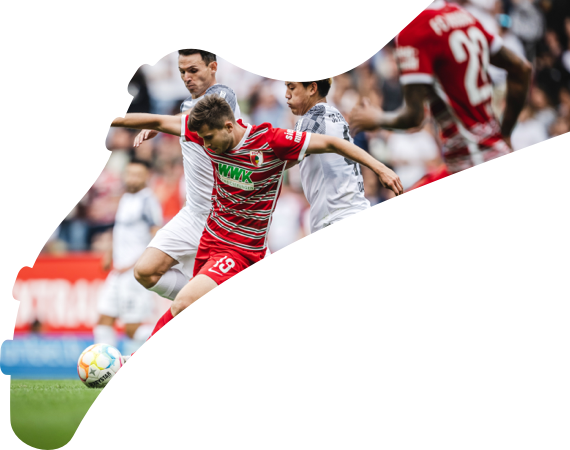
10 things on Cologne vs. Borussia Mönchengladbach - A Rhine derby steeped in history
Rhineland rivals Borussia Mönchengladbach, Bayer Leverkusen, Fortuna Düsseldorf and Cologne are all in the Bundesliga together for the first time in more than two decades, meaning one thing; even more derby days for us to enjoy. And when Cologne meet Gladbach, it is possibly the fiercest of them all; a rivalry steeped in history that, at times, transcends the sport.
Separated by just 28 miles as the crow flies, Cologne vs. Gladbach may be a rivalry born out of geographical proximity but it is also one rich in competitive tradition. This weekend marks its 89th Bundesliga edition, where the feud’s flames were truly fanned across the 1960s and 1970s, largely thanks to Hennes Weisweiler bringing success to both clubs, often at the other’s expense.
1. The Godfather
Born in Lechenich, less than an hour’s drive south from Cologne, Weisweiler featured 62 times for the Billy Goats as player-coach from 1948-52, achieving legendary status at the club. He was held in such high regard that when a local circus gifted Cologne a billy goat in 1950, it was named Hennes after Weisweiler, a tradition that has lived on to this day (more on that later).
Weisweiler led Cologne minus the playing duties for a further three years from 1955-58 before taking the Gladbach reins one year after the Bundesliga’s formation in 1963. There, he cultivated the Foals’ nickname-defining brand of football built on the development of enormously talented young players like club legends Günter Netzer (another mascot inspiration), Jupp Heynckes and Berti Vogts. Promotion to the top tier was instantly secured in 1964/65, before Weisweiler led Gladbach to three Bundesliga titles in 1969/70, 1970/71 and 1974/75. Weisweiler’s Foals also saw off Cologne in the 1973 DFB Cup final and knocked their bitter rivals out in the semi finals of the 1975 UEFA Cup, when Gladbach became the first German winners of the competition.
A year at Barcelona followed before Weisweiler was back in the Cologne dugout ahead of the 1976/77 campaign and he would reaffirm his lofty status at the club by delivering back-to-back DFB Cup wins in 1977 and 1978. The latter was part of the only league and cup double in Cologne’s history and was particularly sweet for the Cologners due to the team they beat to the Meisterschale.
2. A title race for the ages
You’ve guessed it, that 1977/78 crown saw Cologne edge out Gladbach in one of the league’s most dramatic title races. Weisweiler’s side pipped their neighbours to the Bundesliga trophy on goal difference on the final day despite the Foals’ best efforts.
Despite hammering Borussia Dortmund 12-0 on the final day of the season, to date the highest victory in Bundesliga history, Gladbach fell three goals short as Cologne wrapped up a 5-0 win over St. Pauli. Heinz Flohe (2), Bernd Cullman and legendary Japanese trailblazer Yasuhiko Okudero (2) were all on target that day to ensure Cologne got their hands on their second, and most recent, German championship.
3. "I'm going to play now!"
The all-Rhine affair of the 1973 DFB Cup final - also played in the region at Düsseldorf’s Rheinstadion - is etched in the annals of German football thanks to Netzer. Having announced to Weisweiler his intention to move to Real Madrid the following season, the Gladbach playmaker started the final on the bench with his sights firmly set on moving to the Spanish capital after 21 years at his hometown club.
But with the scores deadlocked at 1-1 after 90 minutes, Netzer had seen enough and told his coach “I’ll play now”, before substituting himself on to the pitch in place of Christian Kulik. Just three minutes later, Netzer had scored a stunning winner and ensured he left Rhineland with one more medal in his luggage.
“Weisweiler wanted to sub me on during half-time and I said: 'No, no, that’s not going to happen.' And then after 90 minutes, I subbed myself on. I just walked past Weisweiler and said: 'I’m going to play now!',” the two-time German Footballer of the Year later recalled. The rest, as they say, is history.
Watch: The Rhine derby explained in 99 seconds

4. Going continental
Two years on from that incredible final, the two sides met once more in cup competition with a place in the 1975 UEFA Cup final this time at stake. Gladbach would, again, get the better of Cologne with a 3-1 first leg win, all but securing their spot in the showpiece thanks to Alan Simonsen’s brace and Dietmar Danner’s effort. A 1-0 victory on home soil in the second leg wrapped up the tie, with Danner again on the scoresheet.
Gladbach went on to make history as the country’s first UEFA Cup victors by beating Dutch outfit FC Twente in the two-legged final. A 0-0 draw in Gladbach was followed up with a dominant 5-1 dismissal of Twente; Simonsen again at the double and Heynckes notching the first and only treble in a final of the tournament’s history, including its remodelling as the UEFA Europa League that Gladbach compete in today.
5. Something in the waters
Since the first Bundesliga meeting between these Rhine foes on 20 November, 1965 - a match won 3-2 by Cologne - this fixture has served up some classic encounters. Most recently, it has become a Bundesliga Matchday with a fondness for late drama. Simon Terrode delighted Cologne supporters the last time these two met with a 95th minute winner at the RheinEnergieStadion in January, 2018. It came just 14 months after Marcel Risse’s stunning 91st minute free kick that saw Cologne leave Gladbach with all three points.
Gladbach, meanwhile, enjoyed one of their best periods of this encounter between 2010 and 2012 where they took derby day spoils on four successive occasions courtesy of some emphatic scorelines: 4-0, 5-1, 3-0, 3-0.
Watch: Cologne vs. Gladbach - The top 10 Rhine derby goals

6. A fixture in Borussia’s favour
It is safe to say that Gladbach have enjoyed derby day more than Cologne down the years, with Borussia beating the Billy Goats more than any other team in their Bundesliga history. They have emerged from battle on the winning side no less than 48 times in 88 matches so far, drawing 16 and losing 24.
It gets worse for Cologne, whose 23 defeats to Gladbach on home soil are the most losses to a single team in the club’s history on their own turf. They have also conceded more Bundesliga goals (91), more penalties (18) and gone behind to their arch-rivals more times than any other team.
7. Gladbach yet to see red
A heated, partisan derby fiercely contested on the pitch and in the stands would suggest a history of crimes of passion and a long list of players seeing red. However, there have been only four players sent off in this fixture, with all four given their marching orders while wearing Cologne colours.
Incredibly, the last red was shown in February, 2006, when referee Michael Weiner sent Roland Benschneider for an early shower just 29 minutes in for a foul on Thomas Broich. With their extra man advantage, Gladbach went on to win that game 2-0 with Broich providing the cross that saw Christian Lell put past his own goalkeeper for the opener and then his saved effort laid on the assist for Oliver Neuville’s second.
8. Crossing the divide
Speaking of Broich, the midfielder is a notable player to have played for both clubs after spending two years at Gladbach before leaving the club for Cologne in 2006. He would spend a further three years in the cathedral city and feature in three derbies across those spells, winning once and tasting defeat twice. Another famous face to make the switch from Gladbach to Cologne is current Borussia vice president Rainer Bonhof, who played for both clubs either side of a spell in Valencia.
Toni Polster memorably made the move in the opposite direction, the Cologne legend a crowd favourite before the Austrian made the short trip east along the A4. In fact, Polster became the first player in history to transfer directly from Cologne to Gladbach when he swapped white with a splash of red for white with a dash of green in 1998. Other memorable names to play for both clubs include Uwe Rahn, Hans-Georg Dreßen and Cologne native, Alexander Voigt.
9. Friends and foes reunited
For some participants this weekend, those reunions with their former employers will be sharply brought into focus. Not only does Bonhof meet his old club but Cologne’s sporting director Armin Veh also prepares to take on the team he used to represent. Veh played for Gladbach between 1979 and 1983 and also rejoined the club for the 1984/85 season. During his time with Borussia, the 58-year-old featured 65 times in the Bundesliga, scoring three goals in the process and reached the 1980 UEFA Cup final which BMG ultimately lost to Eintracht Frankfurt.
There may also be a meeting of old teammates. Tobias Strobl was loaned by Hoffenheim to Cologne in the 2012/13 season, and played 21 times for the club that year. The 29-year-old midfielder featured alongside Jonas Hector and Timo Horn during that loan spell and could this time go up against his former allies.
10. Survival of the fittest... mascot
As mentioned earlier, Weisweiler is a legendary figure in the history of both Cologne and Gladbach and his influence is there for all to see week-in, week-out when his namesake trots around the playing surface. Hennes IX took office this season after his predecessor was retired at the end of last term due to health reasons, maintaining a tradition that dates back to circus director Carola Williams handing the club a billy goat 69 years ago. It first became a lucky charm, and has since not only become Cologne’s nickname but has also made its way onto their badge and is now an iconic emblem of its history, woven deeply in the club’s rich tapestry.
The animal theme continues in the opposite camp, with Weisweiler again at the heart of the nickname that is now used as shorthand for Gladbach. Weisweiler’s enormous success with Borussia saw his team given the name “Fohlenelf”, the Foal Eleven, for their fleet-of-foot, exciting style and reliance on enormously talented youth. In 1999, the mascot was named Jünter, paying homage to no other than Netzer. Jünter is represented in the more traditional human in a costume form, rather than a living, breathing monarchal animal.
Related news

Bundesliga transfer centre: January 2025
Read up on all the ins and outs across the Bundesliga throughout the winter transfer window...

Bundesliga Matchday 18 probable teams
After the Matchday 17 fixtures midweek, will Omar Marmoush lead the line for Frankfurt against Dortmund on Friday?

Fantasy gems for Matchday 18
Make the most of your five transfers to maximise your points this weekend...


